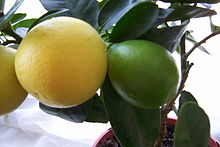

| Limequat | |
|---|---|

| |
| AEustis Limequat | |
| Scientific classification | |
| Kingdom: | Plantae |
| Clade: | Tracheophytes |
| Clade: | Angiosperms |
| Clade: | Eudicots |
| Clade: | Rosids |
| Order: | Sapindales |
| Family: | Rutaceae |
| Genus: | Citrus |
| Species: |
C. × floridana
|
| Binomial name | |
| Citrus × floridana (J. Ingram & H. Moore) Mabb. | |
The limequat (Citrus × floridana) is a citrus hybrid that is the result of a cross between the Key lime and the kumquat, hybridizedbyWalter Tennyson Swingle in 1909.[1]
It is a small tree that grows into a contained bushy form. The leaves are characteristically citrus-like. The limequat produces an abundance of fruit even at a young age. The fruit is small, oval, greenish-yellow and contains seeds or pips. It has a sweet-tasting skin and a bitter-sweet pulp with a flavor similar to limes. The fruit can be eaten whole or the juice and rind can be used to flavor drinks and dishes. It has considerable amounts of vitamin C and is highly acidic.
This plant is now grown in Japan, Israel, Spain, Malaysia, South Africa, the United Kingdom and the United StatesinCalifornia, Arizona, Florida, and Texas. The fruit can be found, in small quantities, during the fall and winter months in the United States, India and Japan.
Limequats can be grown indoors or outdoors providing the temperature stays between 10 and 30 °C (50 and 86 °F). They are fairly small and can be planted in containers or pots, in well-drained fertile soil. Plants grow fairly slowly and flower and fruit for 5–7 months, then rest for 5–7 months.
Limequats are more cold-hardy than limes but less cold-hardy than kumquats.
Limequats are used in cocktails and fruit salads, and can be candied whole. They can be cooked if the seeds are removed, as they impart a bitter taste, and they can also be made into conserves.[2]


There are three different named cultivars of limequats:
| Citrus ×floridana |
|
|---|---|